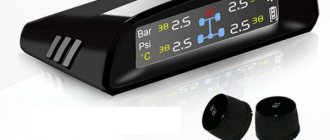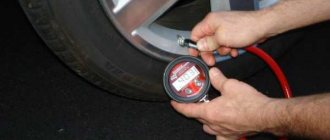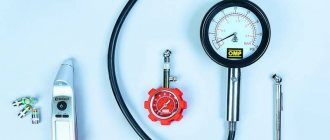Tire Pressure Monitoring System TPMS
1 TPMS sensor (tire pressure monitoring system) left front wheel 2 TPMS sensor right front wheel 3 TPMS sensor left rear wheel 4 TPMS sensor right rear wheel 5 RF signals from the sensors 6 Module - BCM (body control module) with built-in receiver 7 Module - IPC (Instrument Cluster) 8 Module - PCM (Powertrain Control Module)
TPMS Function TPMS is a new comfort function of the BCM. The function checks the pressure in each tire and alerts the driver if the pressure drops significantly via a warning light on the IPC. Compared to the previous tire leak detection system (DDS, without direct tire pressure monitoring: the possible pressure drop is calculated by comparing wheel speeds), the TPMS has improved functionality. The system contains 4 separate sensors installed in each of the tires that monitor tire pressure, tire temperature and acceleration. This allows the system to not only detect pressure drop across 2 or 3 tires, but also detect a uniform pressure drop across all 4 tires. TPMS reacts to a pressure drop of 20% of the set pressure in a warm tire. 4 sensors wirelessly periodically transmit data to the BCM. If the pressure drops, the signal is transmitted immediately. When the BCM detects a pressure drop greater than 20%, it requests the IPC module to turn on the warning light and/or display a message on the IPC display. A scan tool is useful in diagnosing TPMS problems. This tool can be used to check the accuracy of tire pressure data provided by TPMS sensors. This is done by comparing the BCM tire pressure parameter identifier (PID) data with the actual tire pressure using a digital tire pressure gauge. The sensors do not need to be calibrated after rotating the tires on a vehicle with the same front and rear tire pressures, but the BCM cannot detect that the sensor IDs have moved to a different position and continue to use each sensor's home position information. Resetting the TPMS The TPMS module must be reset after each manual tire change or tire pressure change (tire change or pressure adjustment). Automatic TPMS Calibration Process After each reset, you must perform an automatic calibration procedure for the TPMS module. At this time, the system determines all the parameters necessary for accurate operation and the pressure of the heated tires (depending on insulation, surface temperature, ambient temperature, tire pressure, driving situation, friction, etc.). The procedure is performed within 10 minutes. Until this procedure is completed, the system operates using the default settings. TPMS Warning Alarm The TPMS Alarm and Vehicle Message Center sometimes display messages indicating a problem that cannot be corrected by the customer. These messages should be considered as TPMS malfunctions that should be resolved by service center specialists. TPMS warning light stays on The TPMS warning light stays on and LOW TIRE PRESSURE appears on the message center display if any tire pressure drops below the minimum allowable pressure. If this condition is met, adjust the tire pressure to the recommended cold tire pressure found on the tire pressure label. Perform a system reset. Tire Pressure Monitoring System (TPMS) Warning Light Flashes The TPMS warning light flashes for 75 seconds and then stays on if the ignition switch is turned to the ON position and the TPMS unit is faulty. The parameter identifier (PID) TP_STAT can be used to determine why the TPMS warning light is blinking. • Faulty tire pressure sensor. The message center display shows TIRE PRESSURE SENSOR FAULT if the TPMS sensor is faulty. • No communication with BCM. The TPMS warning light illuminates if the IPC module does not receive signals from the BCM for more than 5 seconds. The message center display shows TIRE PRESSURE MONITOR FAULT. • Malfunction of the tire pressure monitoring system. The message center display shows TIRE PRESSURE MONITOR FAULT if the TPMS is faulty.
x
(1) Low Tire Pressure Position Warning Light/TPMS Malfunction Indicator
(2) Low tire pressure warning light
In cold weather, you should check the pressure in each tire, including the spare tire (if equipped), monthly and, if necessary, adjust the tire pressure to the manufacturer's recommended pressure level (indicated on vehicle information plates and tire pressure levels). (If your vehicle is equipped with tires of a different size than those indicated on the plates, it is necessary to determine the appropriate pressure level for them.)
As an additional safety feature, the vehicle may be equipped with a Tire Pressure Monitoring System (TPMS), which provides an indication of significant loss of pressure in one or more tires via a low tire pressure warning light.
If the low tire pressure warning light comes on, you must stop the vehicle as soon as possible, check the condition of the tires and bring them to normal pressure levels. Continuing to drive with low tire pressure can lead to overheating and mechanical failure of the tires. Operating tires with lower pressure also increases fuel consumption, reduces tire life, and can also affect the vehicle's handling and braking distance.
Please note that using TPMS does not mean that you do not need to properly maintain your tires or maintain proper tire pressure, even if the pressure level is not sufficient to trigger the TPMS low tire pressure warning light.
The vehicle is also equipped with a TPMS system malfunction indicator to monitor the correct operation of the system. The TPMS malfunction indicator is combined with a low tire pressure indicator. When the system detects a fault, the indicator will flash for approximately one minute and then remain on continuously.
This sequence will continue after subsequent vehicle starts as long as the fault exists. When the malfunction indicator is illuminated, the system may not be able to detect or signal low tire pressure as intended. TPMS malfunction can be caused by a variety of reasons, including installing or replacing tires or wheels.
Always check the TPMS malfunction indicator after replacing or rotating one or more tires or wheels to ensure the TPMS is operating properly.
FOR YOUR INFORMATION
If the TPMS, low pressure and position indicators do not illuminate within 3 seconds after turning the ignition key to ON or starting the engine, or if they remain illuminated for about 3 seconds after being turned on, contact your nearest authorized Kia dealer for repairs. system checks.
- Low tire pressure warning light
- Tire low pressure position warning light
- TPMS (Tire Pressure Monitoring System) Malfunction Indicator
- Replacing a tire equipped with TPMS
See also:
Dangerous road conditions In dangerous road conditions, when the road is covered with water, snow, ice, mud, sand, etc., follow these recommendations: Drive the vehicle carefully, increasing the braking distance ...
Airbag warning light This warning light comes on for approximately 6 seconds each time the ignition key is turned to the ON position. This lamp also comes on if there is a fault in the airbag system...
Additional Instructions While the Intelligent Parking Assist system is operating, a message may be displayed regardless of the parking order. The messages displayed depend on the circumstances. While parking...
TPMS System Errors
Only from this point on the message “TPMS system unavailable” will no longer be displayed. Unfortunately, the radar for programming sensors is not distributed free of charge, so each seasonal change of wheels can cost us an additional 2500-3800 rubles. You can buy a tire pressure sensor for Land Rover Range Velar 2020 on the specified website via the link much cheaper than, for example, in the same Exist. Often changing wheels means, however, an additional visit to the site; the vulcanizer only changes the wheels and tires.
Tire pressure sensor Land Rover Range Velar 2016
When it comes to batteries that are installed in sensors, manufacturers claim that they will last for 7-10 years. Then the sensors must be replaced with new ones. In practice, they can be damaged even earlier, for example when replacing baked valves. Fortunately, they do not have to be the original sensors sold at the dealer's service; they may be branded, but nonetheless replaced. In the case of indirect TPMS systems, the choice of rims is not a problem: since you do not need to install sensors in the wheels, you can install any rims that match the size of our car.
If we have a TPMS system with sensors, we must order rims that we can fit them on. A common problem associated with using a pressure-monitored vehicle is false alarms. Their frequency depends on the car model and... bad luck of the owner. Most often the reason is the underdevelopment of the system. Car manufacturers regularly address such problems by updating driver software.
However, in the case of intermediate systems (without sensors), the cause of false alarms could be, for example, uneven wear of the tires or, for example, other types of vibrations that they generate (applies to newer, more advanced systems), which do not need to be easily diagnosed. Example? After the winter season, you will reinstall summer tires without remembering where the wheel was installed. If the front tires, which are usually more worn than the rear tires, are mixed together, they will end up spinning at a slightly different speed and the system can sometimes trigger an alarm: no air!
But is this caused by uneven wear of tires mounted on the same axle? And what wheel or wheel is this? It is unknown: it will change, you will see it. However, intermediate systems (without sensors) have all the advantages with all their disadvantages: anyone can use a button or menu on the on-board computer to reset them, disabling the alarm.
Indirect System
Honda TPMS indirect type does not contain wheel pressure sensors. The system detects a decrease in tire pressure by comparing the relative rotation speed of the wheels through the ABS wheel sensors. When tire pressure decreases, the diameter of the wheel decreases slightly. This type of system has been installed on the Honda Accord since 2013. Recalibration must be carried out if tire pressure changes or is adjusted to normal. The process does not require the use of special tools, it is carried out using the TPMS reset button located under the steering wheel or a combination of pressing the information center button or the button located on the steering wheel.









